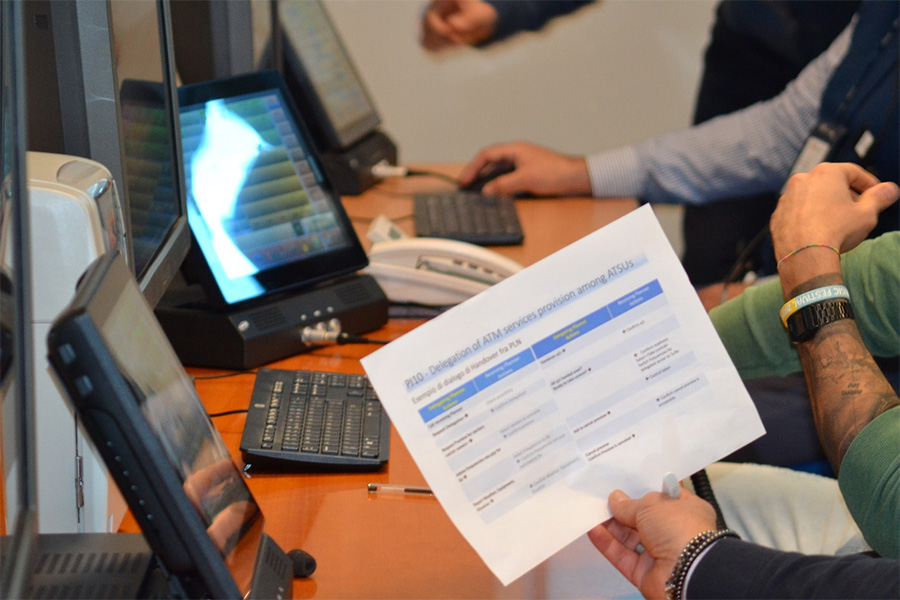
Air navigation service providers (ANSPs) have hosted processing infrastructure remotely for decades, supported by fully redundant networks, to add flexibility. The virtual centre triangle architecture goes a step further, by creating decentralised services that can be used by more than one ATSU. The solution brings versatility in the delivery of air traffic services and supports service continuity in contingency situations. Virtual centres also promise more cost-effective service provision for airspace users since they enable ANSPs to better share resources thereby reduce capital expenditure.
The story so far
SESAR began by demonstrating the technical feasibility of decoupling controller working positions from data service provision and has defined initial interfaces to allow remote connections such as system wide information management (SWIM). SESAR 2020 progressed to wider delegation of airspace, for example during peak traffic times or service degradation, spread geographically across Europe to develop a viable business case as part of the PROSA industrial research project (PJ.10).
Solution lead, Maurizio Romano from ENAV Planning and Research Development Unit emphasises the importance of the service continuity offered by virtual centres: “Operational aspects such as interoperability between two ATM service providers is key. For example, if there is a fire at Milan area control centre, can the services be replaced from Switzerland by just popping up a window to replace the environment in Milan?” As a pre-requisite, controllers would need to be licensed in the different sectors, but the technical aspects and issues around standardisation are top of his agenda, rather than the services themselves.
The project classified virtual centre architectures into different groups according to the level of interoperability between ATM data service providers and ATSUs. Data transfers are easier between systems supplied by the same vendor, such as among members of the Coopans alliance, or between iTEC users, whereas different vendors can result in compatibility issues. SESAR clusters virtual centre implementation according to three main architectures - known as Y, D and U – defined by three principal equipment vendors, Indra, Leonardo and Thales.
Putting virtual centres to the test
Validation exercises conducted by PROSA succeeded in delegating ATM services within a virtual centre environment over wide geographical areas and demonstrated interoperability between ATM data service providers using contingency services. “Cooperation between industry, ANSPs and data service providers is helping to define common standards, supported by Eurocae working group 122,” explains Maurizio. Among demonstrations, four separate ATSUs located in Switzerland, Germany and UK. have been involved in the delegation of ATS services using a validation platform with hardware from different vendors, and supported by a central broker provided by Frequentis in Vienna. This was followed by sector delegation between Madrid and Palma terminal maneouvring areas; and an Italian simulation between Rome and Brindisi that incorporated some military sectors without any negative findings. ENAV also utilised system wide information services (SWIM) infrastructure provided by Coflight cloud services in a virtual centre environment. In northern Europe, controllers simulated flexible sectorisation between Copenhagen and Malmo centres, and finally between Poland and Lithuania.
“The feedback from the controllers is very positive,” said Said Tabti, Skyguide project manager. “We worked with different controllers and different ANSP communities and were still able to apply the same operational procedures everywhere.” He sees a need for more support tools to help controllers manage airspace less well known to them, a pointed echoed by Maurizio Romano who would like to see greater participation by ATC engineers going forward and proposes a new role to monitor data quality.
Where to next for virtual centres?
Both experts are preparing for further activity within the framework of the SESAR 3 JU Digital European Sky research. Virtualisation and cyber-secure data sharing (VITACY) and ISLAND industrial research and validation for capacity-on-demand and dynamic airspace, will explore more complex environments with a specific focus on interoperability aspects and creating a blueprint that manufacturers can take forward. Both projects are currently in the grant preparation phase.
